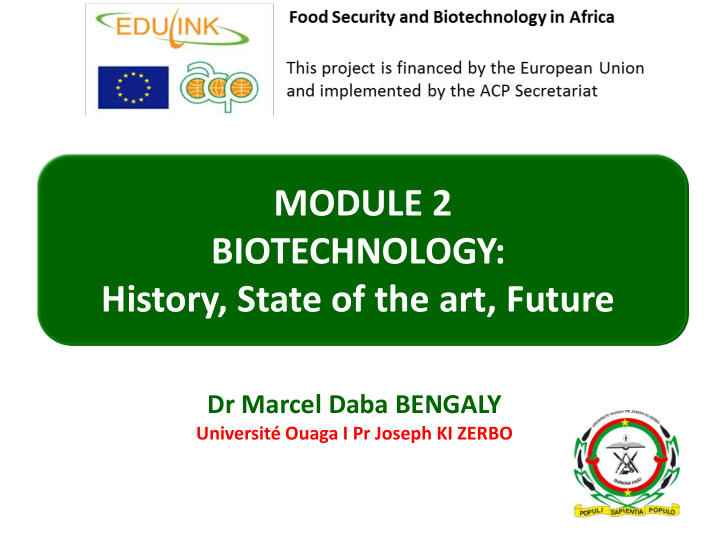



MODULE 2 BIOTECHNOLOGY: History, State of the art, Future Dr Marcel Daba BENGALY Université Ouaga I Pr Joseph KI ZERBO
Module 2 BIOTECHNOLOGY: History, State of the art, Future Disclaimer This publication has been produced with the assistance of the European Union. The contents of this publication is the sole responsibility of the University of Ouaga-I JKZ and can in no way be taken to reflect the views of the European Union. Final Version : February 2017 2
Module Objective 1/2 General objective The main objective is to offer a broad view of biotechnology, integrating historical, global current and future applications in such a way that its applications in Africa and expected developments could be discussed based on sound knowledge … 3
Module Objective 2/2 Specific objectives At completion learner should be able to: • demonstrate knowledge of essential facts of the history of biotechnology and description of key scientific events in the development of biotechnology • demonstrate knowledge of the definitions and principles of ancient, classical, and modern biotechnologies. • describe the theory, practice and potential of current and future biotechnology. • describe and begin to evaluate aspects of current and future research and applications in biotechnology. 4
Module contents 1/1 ‒ Unit 1 Introduction to biotechnology, history and concepts definition ‒ Unit 2: The Green Revolution: impacts, limits, and the path ahead ‒ Unit 3: Agricultural biotechnology: the state-of- the-art ‒ Unit 4: Future trends and perspectives of agricultural biotechnology ‒ Unit 5: Food security and Biotechnology in Africa: options and opportunities 5
Module 2 BIOTECHNOLOGY: History, State of the art, Future UNIT 5: Food security and Biotechnology in Africa: options and opportunities (03 Hours) Dr Marcel Daba BENGALY Université Ouaga I Pr Joseph KI ZERBO 6
Unit 5 Objective 1/1 The objective is to present an overview of Food Insecurity Africa and to discuss the importance of sustainable agriculture in Africa as a key to achieve food security focusing on current and future technologies to increase productivity that are accessible, appropriate and adapted to the needs of smallholders. 7
Unit 5 Content 1/1 1. Overview of Food Insecurity in Africa 2. Case study 3. African Food Security Prospects 8
Overview of Food Insecurity in Africa 1/6 In line with the 2015 deadline set for achieving the Millennium Development Goal targets, Sub-Saharan Africa (SSA) made some progress towards halving the proportion of its population suffering from hunger (MDG 1.C target). Overall, the prevalence of hunger in the region declined by 31% between the base period (1990- 92) and 2015. In other words, approximately one person out of four in SSA is estimated to be undernourished today compared to a ratio of one out of three in 1990-92. FAO, 2015 9
Overview of Food Insecurity in Africa 1/6 Read and synthesize FAO reports on the state of food insecurity in the world and in Africa http://www.fao.org/3/a-i4646e.pdf http://www.fao.org/3/a-i4635e.pdf 10
Overview of Food Insecurity in Africa 2/6 Figure 1: Prevalence of undernourishment in SSA (1990-92 and 2014-16) 11
Overview of Food Insecurity in Africa 3/6 Table 1: Number of undernourished (millions), 1990-92 and 2014-16 12
Overview of Food Insecurity in Africa 4/6 Prevalence of anemia in reproductive women and stunting in children under five years in Sub-Saharan Africa 13
Overview of Food Insecurity in Africa 5/6 Progress towards the World Food Summit (WFS) and Millennium Development Goal (MDG) targets in Sub-Saharan Africa (SSA) 14
Overview of Food Insecurity in Africa 6/6 Case study Based on international and national reports and statistics, analyze the state of food insecurity in your country. Analysis plan : 1. Context of the Country 2. Agricultural production and food availability 3. Market structure and food accessibility 4. Food insecurity, malnutrition and health 5. Challenges and prospects for food security Examples of Reports relevant to the case of Burkina Faso 15
African Food Security Prospects 1/5 Key issues facing African agriculture in the coming decade include: the challenge for the agri-food system to provide for the changing food and nutrition requirements of the evolving population, economic inequality and poverty in rural areas, high population growth without foreseeable demographic transition, maintaining control over coveted natural resources, and the impacts of globalization on Africa agriculture, such as climate change, globalization of markets and the search for new sources of green energy … FAO, 2015 16
African Food Security Prospects 2/5 These challenges : Accelerate sustainable agricultural growth To achieve the most direct reduction of hunger, priority must be given to economic growth in the agricultural sector which hosts the majority of the poor, and has proved to be more effective in reducing poverty than either the manufacturing or service sector … 17
African Food Security Prospects 3/5 These challenges : Promote structural transformation A key challenge consists of modernizing the agri-food system in order to compete in increasingly competitive national, regional and global markets, while providing livelihood, employment and entrepreneurship opportunities to a diverse and young population. Modernization of smallholder agriculture and its integration into the fast-growing agribusiness chains, which can produce quality products that meet the rapidly evolving urban demand (food quality, convenience, safety … ) 18
African Food Security Prospects 4/5 These challenges : Address livelihood risks and uncertainties African farmers face harsh agroecologies and erratic weather, characterized by low soil fertility, recurrent droughts and/or floods. The region is also affected by extreme climate events such as unusual rainfall and temperature patterns. Plant and animal diseases are also a growing threat in Africa … Agricultural risk management strategies, social protection programs, integrated adaptation and mitigation approaches are required to ensure resilient livelihoods and achieve food and nutrition security. 19
African Food Security Prospects 5/5 Discussion topics What may be the role of biotechnology in ensuring food security and sustainable agriculture in Africa ? Supporting reading on biotechnology & food security in Africa . 20
Recommend
More recommend